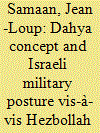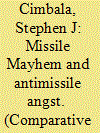| Srl | Item |
| 1 |
ID:
122942


|
|
|
|
|
| Publication |
2013.
|
| Summary/Abstract |
Since 2008, the Dahya concept has been portrayed by journalists, independent experts, and scholars as an official policy of Israel to address the threat of Hezbollah in Lebanon. However, there has been no official Israeli document formulating a Dahya strategy. Although this Dahya concept is not officially endorsed by the Israeli Defense Forces, it is a key reflection of the state of the Israeli military vis-à-vis Hezbollah debate since the 2006 war. This debate reflects a significant evolution of Israeli threat assessment and the remedies for these challenges. It acknowledges not only the political support and military strength of the Lebanese organization, but also its rationality. Conceding the extreme difficulty of dismembering Hezbollah's power, the Dahya concept postulates a deterrence system that, as a matter of fact, finds its roots in traditional Israeli strategic doctrine.
|
|
|
|
|
|
|
|
|
|
|
|
|
|
|
|
| 2 |
ID:
122938


|
|
|
|
|
| Publication |
2013.
|
| Summary/Abstract |
This article argues that government leaders need to bid farewell to the assumption that the rationality of all nuclear states can be assured for all times, that nuclear deterrence can never fail, and that we are somehow "nuclear immortal." It is a fundamental fact of the multinuclear world of the twenty-first century that deterrence built on the threat of a nuclear second strike will not work against "irrational" aggressors.
|
|
|
|
|
|
|
|
|
|
|
|
|
|
|
|
| 3 |
ID:
122941


|
|
|
|
|
| Publication |
2013.
|
| Summary/Abstract |
The political context for nuclear arms reductions, as between the United States and Russia, seemed to stall in 2012 and appeared uncertain as to possible progress during the second term of U.S. President Barack Obama and the third term of Russian President Vladimir Putin. The prospect of a successor agreement to New START that would reduce the numbers of U.S.- and Russian-deployed strategic nuclear weapons to even lower levels was further clouded by Russian objections to U.S. and NATO plans to deploy missile defenses in Europe. The present study considers the political and military aspects of some prospective Obama approaches to post-New START nuclear arms reductions and performs pertinent analysis to consider the relationship between offensive nuclear arms reductions and missile defenses going forward.
|
|
|
|
|
|
|
|
|
|
|
|
|
|
|
|
| 4 |
ID:
122939


|
|
|
|
|
| Publication |
2013.
|
| Summary/Abstract |
Pakistan's nuclear weapons program and proliferation record have often been identified as a threat to regional and international security. Over the last decade, however, the focus of international concern has shifted to questions surrounding the safety and security of Pakistan's military and civilian nuclear complex. As Pakistan's domestic political situation has deteriorated, fears have grown that its nuclear weapons, technologies, and materials may fall into the hands of extremist nonstate actors, such as the Taliban or al Qaeda, imperiling international security. This article presents three major arguments in this respect: significant opportunities exist at each level of Pakistan's nuclear complex for the theft or diversion of nuclear weapons/materials by nonstate actors; a major concern is Pakistan's expansion in its production of high-enriched uranium and plutonium; and the threat to Pakistan's nuclear weapons/materials is significant but has been overstated.
|
|
|
|
|
|
|
|
|
|
|
|
|
|
|
|
| 5 |
ID:
122940


|
|
|
|
|
| Publication |
2013.
|
| Summary/Abstract |
The most common explanation for military victory and defeat is numerical preponderance. This is the causal assertion that the preponderant will use their material advantage optimally and win the military conflicts they engage in through attrition. When it comes to battle, more is better, whether it be troops in the field or raw economic potential. Regrettably, this big battalions theory has rarely been tested, particularly against a series of cases with great historical breadth. This article analyzes data from 754 battles spanning nearly 3,500 years, and contrasts these empirical details against the core hypotheses of preponderance theory. Unfortunately for the theory, the returns to preponderance are highly ambiguous. Historically, armies both large and small emerge victorious in nearly equal fashion-a result highly contrary to the theory's central claim.
"We are practically through the enemy's defences, the enemy has only flesh and blood against us."
|
|
|
|
|
|
|
|
|
|
|
|
|
|
|
|